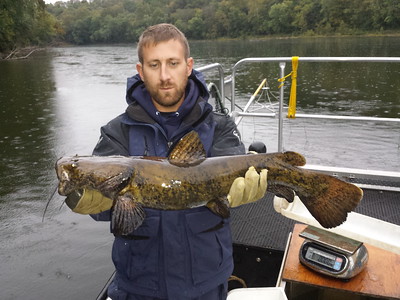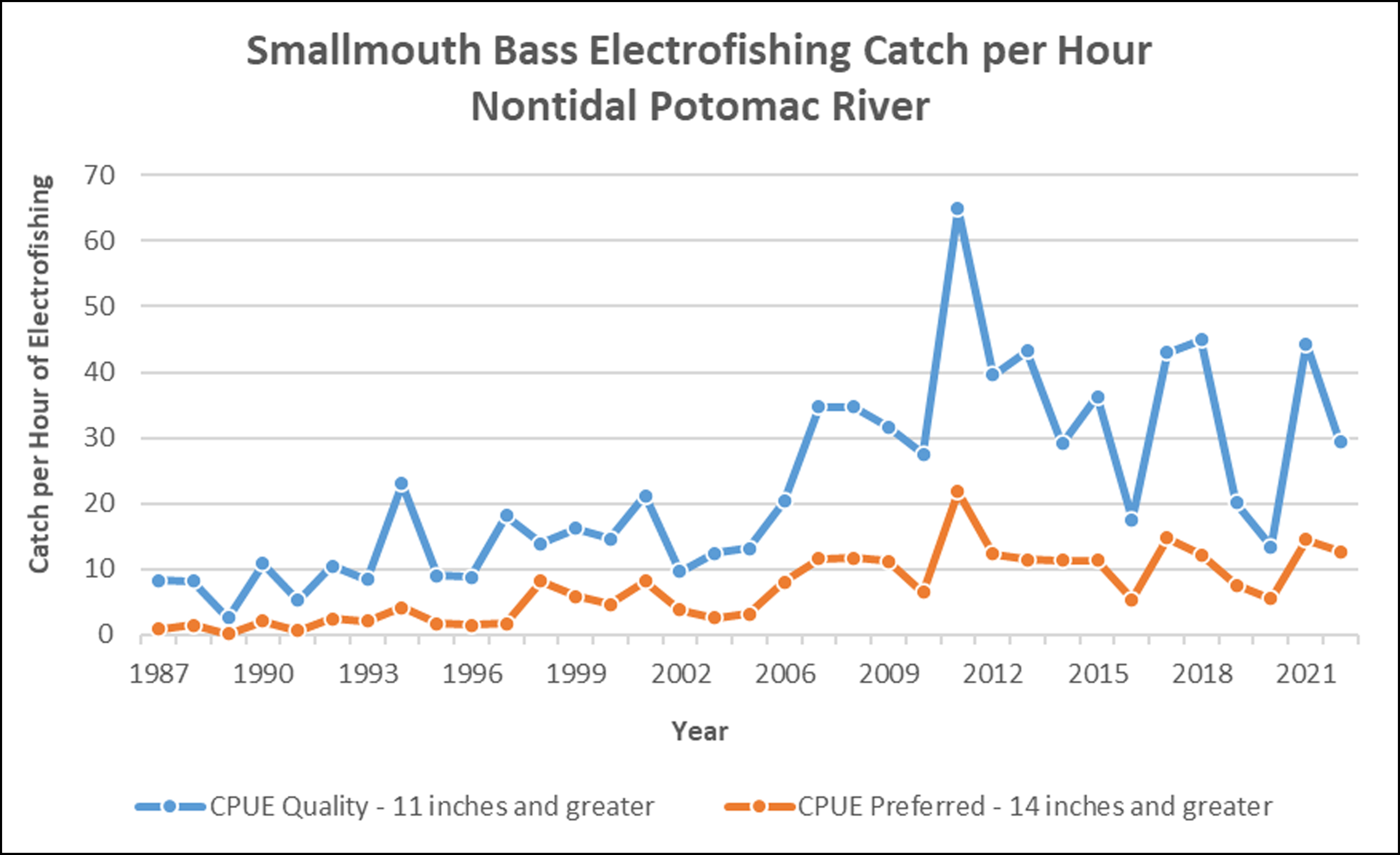Located in Allegany, Washington, Frederick and Montgomery Counties
Useful Links
 Physical/ Habitat Description - The warmwater nontidal Potomac River, commonly referred to as the “Upper Potomac”, stretches from Cumberland to Washington D.C., forming Maryland’s southern boundary for over 200 miles. The watershed drains roughly 11,200 square miles encompassing Pennsylvania,
Physical/ Habitat Description - The warmwater nontidal Potomac River, commonly referred to as the “Upper Potomac”, stretches from Cumberland to Washington D.C., forming Maryland’s southern boundary for over 200 miles. The watershed drains roughly 11,200 square miles encompassing Pennsylvania,
 Maryland, West Virginia, and Virginia. This major river system supports a natural flow regime with only two small hydroelectric dams (Dams 4 & 5, in Washington County, MD) on the mainstem. The North Branch Potomac River upstream of Cumberland is managed as a trout fishery. Downstream of Cumberland, a variety of habitats are present. The more forested western sections of the river (Allegheny and western Washington Counties) provide cooler temperatures, a fair to moderate gradient, and a mix of pea gravel, boulder, cobble, and bedrock substrates. Flowing southeast from the Hagerstown Valley, the watershed changes into a much higher percentage of urban and agricultural land use that is greatly influenced by the surrounding limestone geology. Here you will find a mix of pool, glide, and riffle habitats. From eastern Frederick County through Montgomery County, the gradient is much less with a higher presence of pool/glide habitats that maintain a shallow profile. Submerged aquatic vegetation can be extensive in the lower reaches.
Maryland, West Virginia, and Virginia. This major river system supports a natural flow regime with only two small hydroelectric dams (Dams 4 & 5, in Washington County, MD) on the mainstem. The North Branch Potomac River upstream of Cumberland is managed as a trout fishery. Downstream of Cumberland, a variety of habitats are present. The more forested western sections of the river (Allegheny and western Washington Counties) provide cooler temperatures, a fair to moderate gradient, and a mix of pea gravel, boulder, cobble, and bedrock substrates. Flowing southeast from the Hagerstown Valley, the watershed changes into a much higher percentage of urban and agricultural land use that is greatly influenced by the surrounding limestone geology. Here you will find a mix of pool, glide, and riffle habitats. From eastern Frederick County through Montgomery County, the gradient is much less with a higher presence of pool/glide habitats that maintain a shallow profile. Submerged aquatic vegetation can be extensive in the lower reaches.
 Boating Access - The Chesapeake and Ohio (C&O) Canal National Historic Park parallels the nontidal Potomac River in its entirety (184.5 miles), offering public access along the Maryland shoreline. Numerous public boat ramps exist throughout the river, offering additional recreational access opportunities (see link above). Jet-drive boats or paddle/floatable vessels are typically recommended to navigate this river due to the shallow rocky profile. The impounded sections upstream of both hydroelectric dams offer deeper water that appeals to those with larger vessels; water skiing and personal watercraft are very popular during the summer months. A lifejacket MUST be worn at all times between November 15th and May 15th while on the Upper Potomac River unless anchored. Maryland Law requires all children under the age of 13 to wear a USCG approved PFD while underway on a recreational vessel under 21 feet.
Boating Access - The Chesapeake and Ohio (C&O) Canal National Historic Park parallels the nontidal Potomac River in its entirety (184.5 miles), offering public access along the Maryland shoreline. Numerous public boat ramps exist throughout the river, offering additional recreational access opportunities (see link above). Jet-drive boats or paddle/floatable vessels are typically recommended to navigate this river due to the shallow rocky profile. The impounded sections upstream of both hydroelectric dams offer deeper water that appeals to those with larger vessels; water skiing and personal watercraft are very popular during the summer months. A lifejacket MUST be worn at all times between November 15th and May 15th while on the Upper Potomac River unless anchored. Maryland Law requires all children under the age of 13 to wear a USCG approved PFD while underway on a recreational vessel under 21 feet.
Fish Species Managed - (Smallmouth bass, Largemouth bass, Walleye, Muskellunge, Channel Catfish) - The nontidal Potomac River is Maryland’s most popular freshwater fishing destination. The river supports populations of warmwater and coolwater gamefish species offering yearround fishing opportunities.

Walleye were introduced into the fishery from stockings initiated in 1979. Since that time, natural reproduction combined with supplemental stockings to add to the overall year-class strength has maintained a productive fishery. Walleye are distributed throughout the Upper Potomac with the highest densities occurring from Dam 5 downstream to Point of Rocks. Walleye remain active throughout the winter months and provide good fishing while other species remain less active. Population metrics suggest that larger individuals make up a significant proportion of the population; walleye greater than 20 inches have made up as much as 40 percent of the spring electrofishing sample and roughly 37 percent were within the 15–20-inch slot limit. Current regulations for Potomac River walleye were designed to protect spawning fish; especially, the larger females, which contribute most to recruitment. Minimum size: 15 inches year-round, with a daily creel of 5 fish per day. From January 1 – April 15, the minimum size is 15 inches and the maximum harvestable size is 20 inches.

Muskellunge (aka muskie) are an exciting and relatively new addition to the Potomac River sport fishery. Much information on the muskie fishery can be found on the Muskie Program webpage above.
Channel catfish is an introduced, naturalized species now distributed throughout the Potomac River watershed. Prized for their availability, willingness to bite, and as table fare, channel catfish have been the staple of catfish anglers for more than a century. The nontidal Potomac channel catfish population has remained fairly stable over the past decade. Recent surveys indicate a relative abundance of 40 – 60 channel catfish per electrofishing hour with three quarters of the population within the 12 – 20 inch size range. A slight decrease in the number of juvenile channel catfish has been observed, which may be a result of the increasing population of invasive flathead catfish within this system.

Flathead catfish are an introduced, invasive species, first collected in Upper Potomac fishery surveys in 2012 and are currently distributed from Dam 5 downstream to the District of Columbia. From 2016 to 2021, a three fold increase in relative abundance and a shift to larger-sized fish were documented. Flathead catfish are apex predators capable of exceeding 40 pounds. Their dietary preference for large, live fish makes them likely to have impacts to native and naturalized species. The literature provides many examples of negative impacts on the existing fish communities when flathead catfish are introduced into new ecosystems. The departments asks anglers to:
- Remove and kill any blue and flathead catfish they catch.
- Catch and release of these fish is discouraged, as they are invasive top predators and pose a serious long-term threat to our native species.
- In Maryland, it is illegal to transport live blue and flathead catfish into another body of water, anyone in violation of this can be fined up to $2,500.
- To report illegal transport or unauthorized introductions of invasive species please contact the Natural Resources Police at 800-628-9944.
A tagging study was initiated in 2019 to gain more information on flathead catfish movement, growth, and mortality in the Potomac River. Freshwater Fisheries and Hatcheries staff continue to gather additional information on the distribution, growth, and abundance of flathead catfish as well. Anglers are encouraged to harvest any flathead catfish they catch and report tagged fish. Report catching a blue catfish or a flathead catfish using
Maryland's Invasive Species Tracker.

First introduced to the Potomac River in 1854 from the Youghiogheny River (Ohio drainage) by a railroad worker, smallmouth bass found the Potomac to their liking and quickly spread throughout the watershed. Smallmouth bass are now the most sought-after gamefish in the nontidal Potomac River due to their availability throughout the watershed and their tenacious and feisty disposition. The population has thrived solely by natural reproduction for more than a century. However, over the past decade reproductive success has declined, believed to be due in large part to spring high flow events in May and June; although intersex, contaminants, pathogens, and increased parasite loads may also be contributing. With suppressed reproduction occurring over a prolonged period, angling and electrofishing catch rates of adult smallmouth bass declined.

A
supplemental stocking project was initiated in 2019 to produce smallmouth bass juveniles in a controlled hatchery environment and then stock them into the river where natural recruitment has been most impacted. The combination of supplemental stocking and improved natural reproduction has improved the fishery; the current status of this fishery is one that should be attractive to anglers. Survey results indicate that the number of quality size (11 inches and greater) and preferred size (14 inches and greater) smallmouth bass has increased over time and is well above the established benchmark. FFHD will continue the supplemental stocking through 2024 and determine the contribution of hatchery produced juveniles to the population as well as monitor the size distribution of the adult population.
Contact Us - Comments and questions regarding the fishery management of Owens Creek can be directed to:Maryland Department of Natural Resources
Fishing and Boating Services
10932 Putman Road
Thurmont MD 21788
301-898-5443